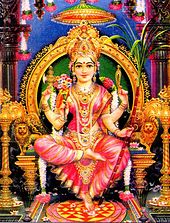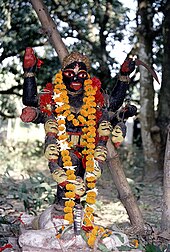Shaktism

Shaktism ( Sanskrit शाक्त Śākta [ ˈʃɑːktʌ ] "belonging to Shakti") is a form of Hinduism that refers to the female gods or the goddess . This so-called Shakti , the primordial force of the universe thought of as feminine, has in this form of religion an outstanding meaning in salvation events and in the world process, in which the male deity acts only through its energy, which is Shakti. The position of the goddesses within the individual cults is different. She can represent the “highest one” or the central philosophical concept, the attribute of a male universal god or an autonomous, benevolent or cruel mother goddess. There are female deities in every Hindu cult . The demarcation to these cults lies in the fact that in Shaktism one or more goddesses, who are understood as energies, directly condition the salvation events and the processes of the world and are worshiped in a cult.
history
Shaktism is closely interwoven with Indian Tantrism and, along with Shaivism and Vishnuism, is one of the three main directions of Hinduism . Its origins are in the 4th to 7th centuries. Historically, Shaktism emerged in its more pronounced form after Tantrism and had its heyday in the 8th to 10th century, when many of its texts were written. In the 12th to 14th centuries there was a mature teaching, but most of the literature of this direction was created in the 17th to 19th centuries and texts of Shakta Tantra are still being created today. The origins of Shaktism can already be found in the Vedas and among the Dravidian-speaking indigenous people of India. The most important writings of the followers of Shakti are the Devi Bhagavata and the Devi Mahatmya , part of the Markanadeya- Purana .
A distinction is made between two main forms of Shaktism: The Shri -Kula (family of the goddess Shri) are mainly represented in southern India, while the Kali-Kula (family of the goddess Kali ) are widespread in northern and eastern India. The Kali-Kula rejects the Brahmin tradition.
The Indian folk religion , in which the worship of female deities already predominates, has contributed greatly to the spread of Shaktism .
The worship of goddesses themselves is ubiquitous in India and has great significance in daily life.
theology
In terms of religious history, Shaktism derives from Shivaism , and its theology hardly deviates from that of Shivaism, although it is not Shiva but Shakti that is regarded as the highest principle. This will u. a. This is based on the fact that in Shivaism Shiva is the pure spirit that is passive, while his Shakti is its active principle, so that Shaktas see Shiva as incapable of action without his Shakti and this is therefore the creative aspect of the divine. Shakti is seen as a magical creative force ( Mahamaya ) and mother of the world.
The theology of Shakta is basically monistic and shaped by Vedanta , since Devi is viewed as the manifestation of Brahman . However, in contrast to Vedanta, Maya is viewed as a conscious force in which the various aspects of the goddess appear and she is also worshiped as a personal deity.
Shakta tantra
From the 10th century Shaktism also became tantric . Practices such as pujas , offerings and meditation mixed with esoteric contents of tantrism, especially with tantra yoga . In this physical and mental techniques are used: meditation, japa , mantras and yantras as well as asanas and other physical exercises. The Shakti is seen here as Kundalini and each chakra is equated with a goddess. Mukti , redemption, is seen in Shakta Tantra in the fact that the Kundalini has risen through all chakras and the practitioner reaches Siddhantacara, the "perfect worship" that leads to liberation (from samsara ). This state is called Jivanmukti, "already liberated in life".
Mythology and forms of Shaktism
Forms of Shaktism are for example the worship of the goddess Durga , who is one with the absolute, the Brahman , and is regarded as the mistress of the world and the other gods. Even Shiva is dependent on it, it exists, according to the Shaktianhänger through it and it is as Mahayogini that exists creator, destroyer and preserver provider of the world forever. Her attributes are the trident of Shiva, the discus Vishnus , the thunderbolt Indras , the noose Varunas and other symbols that the gods gave her according to the myths. Your companion animal is the lion or the tiger. Durga in her many forms is the most popular goddess in India and is revered as a weapon-bearing fighter, but also as the highest mother.
In the form of the Durga, the Shakti is unbound, without a husband. In other cults she also appears as Lalita , a red-colored goddess who sits on Shiva's lap and whose symbols are the sugar cane bow (including a symbol of the human spirit), flower arrows (symbolizing, among other things, the world of the senses), the net (including a symbol of love and of desire) and the club (including a symbol of anger and aversion).
The worshipers of the great mother, the Shaktas, are mostly also associated with Shaivism , while in Vishnuism the goddess generally has no outstanding meaning.
Mahadevi plays a special role in Shaktism , as she is considered the all-being and goddess of the absolute, who appears in different forms (e.g. as Lakshmi , Sarasvati or Parvati ) and is superior to the male gods as the creative aspect of Brahman .
In some more philosophical directions of Shaktism, Shakti is considered to be the kinetic aspect of Brahman, the only true being, which lets everything emerge from itself, carries it within itself, and takes it back again, and the Maya , the manifested world and the polarities contained therein, and which is itself .
In other forms of Shaktism, Shakti does not have the same dominant position, but is thought of as the immanent creative power of the male Shiva and is regarded as the manifestation of ultimate reality. Shiva here symbolizes the absolute in its resting aspect, while the feminine thought Shakti is its energy that emerges from it and that creates, maintains and destroys the universe. The Shakti is the energy of redeeming knowledge, will and action. The male god is seen here as the passive principle ( Purusha ), the goddess as the active principle ( Prakriti ). Together they form a unit.
The iconography also reflects the different meanings of the Shakti: Sometimes she stands triumphantly on the immobile, passive body of Shiva, or they both form a bisexual Ardhanarishvara (half man, half woman), then again she sits as a beloved wife ( Uma -Maheshvara) on Shiva's lap.
In some directions of Shaktimus the Shakti is Kali , which like nature can be cruel and unpredictable and also demands bloody sacrifices. In the Kali cult, the opposites of birth and death, arising and passing away, beauty and horror of life are understood as a unity. That is why believers also venerate the dark sides of the Kali, not only paying homage to her on the house altar or in the temple, but also on cremation sites. In the past people even made human sacrifices. However, Kali is also considered a savior and loving protector. She is Kalima, d. H. the mother Kali, who can help people in their struggle against the entanglements of the sense world, the bondage to the world and death.
In the worship of Shakti, followers of tantric schools often celebrate rituals such as pancatattva. These include the consumption of intoxicating drink (Mada), fish (Matsya), meat (Mamsa), grain (Mudra) and sexual union (Maithuna). It is believed that these five things belong to Shakti and that they can be raised to a higher level through ritualization. In this way, the satisfaction of human needs should be able to experience a transformation into divine processes. Maithuna, the ritual sexuality, is actually practiced by very few Shaktas, most of them reject it or only carry it out symbolically. However, in the past, sacred prostitution was often an accompaniment of tantric shaktism and the sexual act was experienced as a unio mystica with the great mother, the goddess of life, love and fertility.
Yantras
The religious life of followers of the goddess also includes yantras , geometric diagrams made of points, lines, circles and triangles. One draws them z. B. on the floor, on paper or scratches in metal plates. These signs represent the formless aspect of the goddess. In worship, they can be at the center instead of a statue or an image. By reciting mantras , according to her followers, the goddess manifests herself in this drawing and is present through her.
literature
- Jan Gonda : The Religions of India; 2. The younger Hinduism in: The religions of mankind Vol. 12 , ed. by Christel Matthias Schröder ; Kohlhammer, Stuttgart [et al.], 1963
- David Kinsley : Hindu Goddesses . University of California Press 1986 ISBN 0-520-05393-1
- Heinrich von Stietencron: The Hinduism . CH Beck, Munich 2001
- Denise Cush, Catherine Robinson, Michael York (Eds.): Encyclopedia of Hinduism. London (et al.), Routledge 2008





